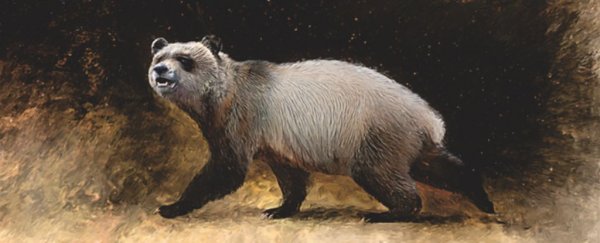Giant pandas were not always native solely to China – and they didn't always love bamboo.
A pair of fossilized panda teeth, originally found in northwestern Bulgaria, suggests these lovable bears once roamed across Europe where they gobbled up much softer plants than their modern cousins.
The Bulgarian gnashers do not belong to a direct ancestor of today's giant pandas but to a close relative that lived approximately 6 million years ago on the eastern edge of Europe.
Experts say this species would have been about the same size or slightly smaller than today's giant pandas.
Judging by the material in which the fossil was found, the ancient panda likely lived in a swampy forest and feasted on vegetation.
Unlike modern pandas, however, the cusps of its teeth do not appear strong enough to pulverize the woody stems of bamboo. Instead, its meal of choice was likely something softer.
Still, its teeth were suited for tougher foods than older related species – a discovery that fits nicely with the idea that modern giant pandas evolved from a carnivorous bear to fill an ecological niche millions of years ago.
"The likely competition with other species, especially carnivores and presumably other bears, explains the closer food specialization of giant pandas to vegetable food in humid forest conditions," says paleontologist Nikolai Spassov from Bulgaria's National Museum of Natural History.
Giant pandas are often said to be living fossils because they have changed so very little throughout their evolutionary history. Yet that doesn't mean their family tree is a straight shoot.
In fact, there are so many disparate branches that researchers are having a tough time weaving them together.
It is possible that giant pandas evolved in Europe from carnivorous bears before they headed eastward. But it is also possible they originated in Asia, while another branch spread to Europe and went extinct.
The most likely relative of modern giant pandas lived in China 8 million years ago. But recently, the fossilized teeth of a panda-like creature were unearthed in Hungary and dated back a further 2 million years.
There's always a chance an older fossil will be found one day, but based on these dates, it is likely that pandas originated in Europe before moving eastward.
Named Agriarctos nikolovi after the Bulgarian paleontologist Ivan Nikolov who first cataloged the teeth in the 1970s, this newly described species could have been one of Europe's last pandas.
"Giant pandas are a very specialized group of bears," explains Spassov.
"Even if A. nikolovi was not as specialized in habitats and food as the modern giant panda, fossil pandas were specialized enough and their evolution was related to humid, wooded habitats. It is likely that climate change at the end of the Miocene in southern Europe, leading to aridification, had an adverse effect on the existence of the last European panda."
Clearly, the family background of the giant panda is not so black and white.
The study was published in the Journal of Vertebrate Paleontology.
